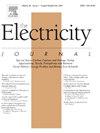Assessing the impact of rural electrification on gender inequality in rural India: A state-level analysis
IF 2.2
Q1 Social Sciences
引用次数: 0
Abstract
Electricity has an unswerving impact on financial sustainability of a country; hence, everybody must have equal access to electricity. However, in a developing country like India, the inequality in electricity distribution intensifies in the rural areas and gets further skewed with respect to gender. The skewness is owing to the differential gender needs. The study has attempted to empirically analyze the impact of rural electrification on gender inequality across rural areas of 36 Indian states and union territories over 2015–2019. Gender inequality is measured through the ratio of female and male rural labor force participation, while rural literacy gap and self-help group loans are taken as controls. The analysis is carried out at the aggregate level, followed by segregation based on presence or absence of women police stations, geographical regions, and quantiles. The results show that although rural electrification and other drivers of gender inequality can have positive impact on achieving rural gender equality in rural India, there is need of policies that can help in maximizing use of electrification.
评估农村电气化对印度农村性别不平等的影响:一项州级分析
电力对一个国家的财政可持续性有着不可动摇的影响;因此,每个人都必须有平等的用电机会。然而,在印度这样的发展中国家,电力分配的不平等在农村地区加剧,并且在性别方面进一步倾斜。这种偏差是由于性别需求的差异造成的。该研究试图实证分析2015-2019年印度36个邦和联邦直辖区农村地区电气化对性别不平等的影响。性别不平等通过农村男女劳动力参与率来衡量,农村识字率差距和自助团体贷款作为对照。分析是在总体一级进行的,然后根据有无女警察局、地理区域和分位数进行隔离。研究结果表明,尽管农村电气化和其他性别不平等的驱动因素可以对实现印度农村的农村性别平等产生积极影响,但仍需要制定有助于最大限度地利用电气化的政策。
本文章由计算机程序翻译,如有差异,请以英文原文为准。
求助全文
约1分钟内获得全文
求助全文
来源期刊

Electricity Journal
Business, Management and Accounting-Business and International Management
CiteScore
5.80
自引率
0.00%
发文量
95
审稿时长
31 days
期刊介绍:
The Electricity Journal is the leading journal in electric power policy. The journal deals primarily with fuel diversity and the energy mix needed for optimal energy market performance, and therefore covers the full spectrum of energy, from coal, nuclear, natural gas and oil, to renewable energy sources including hydro, solar, geothermal and wind power. Recently, the journal has been publishing in emerging areas including energy storage, microgrid strategies, dynamic pricing, cyber security, climate change, cap and trade, distributed generation, net metering, transmission and generation market dynamics. The Electricity Journal aims to bring together the most thoughtful and influential thinkers globally from across industry, practitioners, government, policymakers and academia. The Editorial Advisory Board is comprised of electric industry thought leaders who have served as regulators, consultants, litigators, and market advocates. Their collective experience helps ensure that the most relevant and thought-provoking issues are presented to our readers, and helps navigate the emerging shape and design of the electricity/energy industry.
 求助内容:
求助内容: 应助结果提醒方式:
应助结果提醒方式:


